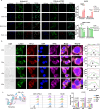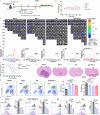A covalent peptide-based lysosome-targeting protein degradation platform for cancer immunotherapy
- PMID: 39910101
- PMCID: PMC11799215
- DOI: 10.1038/s41467-025-56648-6
A covalent peptide-based lysosome-targeting protein degradation platform for cancer immunotherapy
Abstract
The lysosome-targeting chimera (LYTAC) strategy provided a very powerful tool for the degradation of membrane proteins. However, the synthesis of LYTACs, antibody-small molecule conjugates, is challenging. The ability of antibody-based LYTACs to penetrate solid tumor is limited as well, especially to cross the blood-brain barrier (BBB). Here, we propose a covalent chimeric peptide-based targeted degradation platform (Pep-TACs) by introducing a long flexible aryl sulfonyl fluoride group, which allows proximity-enabled cross-linking upon binding with the protein of interest. The Pep-TACs platform facilitates the degradation of target proteins through the mechanism of recycling transferrin receptor (TFRC)-mediated lysosomal targeted endocytosis. Biological experiments demonstrate that covalent Pep-TACs can significantly degrade the expression of PD-L1 on tumor cells, dendritic cells and macrophages, especially under acidic conditions, and markedly enhance the function of T cells and tumor phagocytosis by macrophages. Furthermore, both in anti-PD-1-responsive and -resistant tumor models, the Pep-TACs exert significant anti-tumor immune response. It is noteworthy that Pep-TACs can cross the BBB and prolong the survival of mice with in situ brain tumor. As a proof-of-concept, this study introduces a modular TFRC-based covalent peptide degradation platform for the degradation of membrane protein, and especially for the immunotherapy of brain tumors.
© 2025. The Author(s).
Conflict of interest statement
Competing interests: The authors declare no competing interests.
Figures







References
MeSH terms
Substances
Grants and funding
LinkOut - more resources
Full Text Sources
Medical
Research Materials
Miscellaneous

